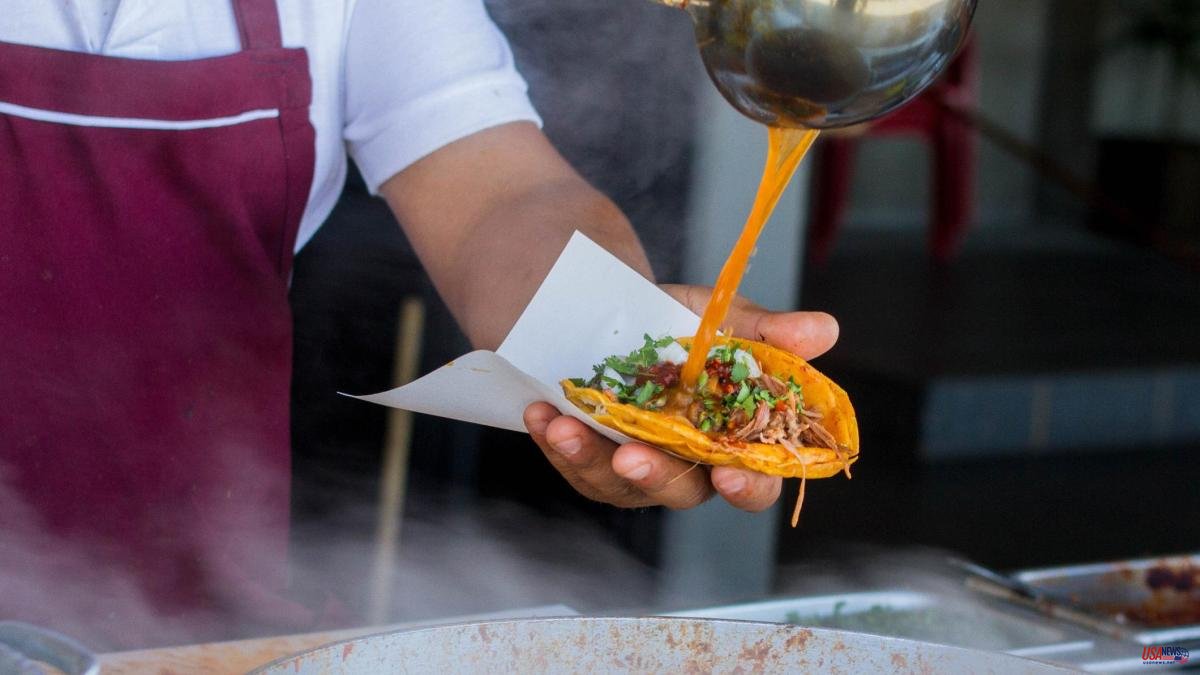Feeling the smell of a grilled choripán when leaving a stadium in Argentina, walking through the streets of Guadalajara (Mexico) to return to eat tacos for breakfast with your father as you did when you were five years old or running out of the airport to go devour a full every time you visit Chile. They are stories that represent the close relationship that Latin Americans maintain with their gastronomy.
Country after country, even city after city, there is a characteristic dish or sandwich that has settled in the culture of the place, becoming the protagonist of breaks at work, meetings with friends and party nights. A role that blends in with the hustle and bustle of everyday life.
That is why a trip to this continent requires first-hand knowledge of what to eat. Five Latinos and Latinas from Argentina, Chile, Colombia, Brazil and Mexico talk about the street food that they would recommend with their eyes closed to anyone who decides to visit one of these countries and ventures to discover the idiosyncrasy of a town through its cuisine.
"For me, making reminiscences from the birria taco is remembering my life," says documentary filmmaker Christian Jiménez. At just 5 years old, his father took him to eat tacos in the morning before dropping him off at school. At twenty, His travels through Mexico led him to look for the different types of tacos that exist and the way in which they are produced.For this reason, he knows that the Jalisco birria taco is served with the juice of the meat as a consommé and that in this region it is where the meat is crispier on the outside.You also know that in Hidalgo it is cooked in an artisanal way and the birria is slowly cooked in a pit with charcoal.
This type of taco can be prepared with beef (ox), goat or veal and takes advantage of the whole animal. The process is long and begins with the preparation of the marinade -a mixture of four chili peppers combined with garlic, bay leaf, cloves and other herbs-, which is poured all over the animal. Then it is placed in a well or hot pot and covered with maguey leaves, which is the tequila plant. After 12 hours it is ready to chop and put in the tortilla with a little onion, cilantro and, of course, hot sauces.
This street food, says Jiménez, has represented an opportunity for many families in Mexico to have a livelihood. And it is that, for him, this preparation symbolizes the history of the country and at the same time, his own. “Without the taco you cannot understand Mexican culture. I believe that if you put a taco on the flag, it is more representative than the Eagle”, he affirms. Now that he lives in Barcelona, it's hard for him to imitate this dish because most of the essentials, like chili peppers, can't be found. Also, the difference is not only in taste. "In Mexico, the cheapest taco costs 15 cents and the most expensive two euros," says Christian.
“A classic from Argentina, which you will find everywhere, even when you go to the stadium, is choripán”, says Antonella Reinero (28 years old), a fan of Club Atlético Boca Juniors. Born in Mar del Plata, her choice is a sandwich that is only based on two ingredients: bread and chorizo (similar to a large chistorra). "If you ask me specifically what the difference is, I can't explain it to you, but I can tell you that it's noticeable," says Reinero, who because of this dissimilar flavor has had to go looking for the original chorizo at an Argentine butcher shop since he moved. to Barcelona in 2018.
What crowns this sandwich is the sauce and for Reinero there are two that are not lacking in every street stall or restaurant that sells choripán. The criolla, his favorite, is an oily mixture of chopped onion, pepper and tomato. The other, more internationally known, is chimichurri, whose star ingredients are parsley and garlic. But whether with one or the other, the choripán is part of the daily life of the Argentine people in a transversal way, either in the Sunday barbecue or as a fast food. “There is never a shortage on a grill, and I think that is the relationship we have in Argentina with choripán. It is something that always occurs to you to add to the table”, says the young woman.
His favorite place to enjoy this classic is called El sochori de dorapa, a small restaurant located in front of “Minella”, the soccer stadium in Mar del Plata, one of the country's tourist cities. But now that she lives in Catalonia, she is the one in charge of preparing this famous sandwich. “I made the decision that I didn't want to depend on any man to cook me a barbecue, because out of habit it's a very masculine space where women made the salads and washed the dishes. I wanted to have my own place and be able to eat barbecue whenever I wanted and with whoever I wanted, ”concludes Reinero, who often invites his friends to a“ choripanada ”at his house, with criolla sauce included.
His family calls César Johnson "the king of completeness." And it's not hard to see why. He himself declares himself addicted to this classic Chilean street food with which he has had a long relationship. "It evokes wonderful memories in me," he says. He says that, since he was little, his father took him to lunch with his colleagues, and that he could eat up to four of them. "He was a complete eating machine," Johnson states.
In Chile, the most popular completo is the Italian, which has bread, sausage, tomato, avocado and homemade mayonnaise. But Johnson likes the complete set, which in addition to these ingredients includes sauerkraut, Chilean-style American sauce (chopped pickled onion, pickle and carrot), mustard and an extra addition from the young man: a bit of national chili pepper. “Formerly they prepared it with everything, but later people changed the habit to Italian”, he affirms. This sandwich can be found in street carts and also in soda fountains (typical sandwich and drink restaurants).
Every time Johnson visits Chile, he gets off the plane and goes straight to eat a couple of completos at Dominoes. He has lived in Barcelona for 15 years and admits that he has moved away from other typical dishes, but never from the complete one. “It is part of our idiosyncrasy. When he was little, before the birthday cake, we ate completely ”. He also gets used to eating this dish at lunches and onces —the snack— and, for that reason, for César “the best complete is the one that I enjoy with the family”. And for those who decide to visit his country, he is blunt: "Traveling to Chile and not eating full, is like going to Barcelona and not seeing the Sagrada Familia."
In the streets of Medellín (Colombia) a perfect sandwich was born to reduce the drunkenness after partying and it is Marta Castaño's favorite. Abundant, huge and tasty, the perra is a kind of hot dog whose base is grilled bacon buried in a bath of melted cheese. On top it can have various ingredients such as vegetables, various sauces such as pineapple, a quail egg and the final touch: very thin fried potatoes that in Colombia are known as papas ripio.
This sandwich is a variation of El Perro, which instead of bacon has sausage. "The way they prepare it..., it doesn't look the same at home," says Castaño, because it is "a craving you buy on the street." This great sandwich is usually found in carts or restaurants that are open during the day and until after four or five in the morning. But it's not just a late-night meal. “When you started going out with your friends as a teenager and you couldn't go to the clubs, then the plan was to go to these places and eat a bitch,” he recounts.
But street food is more than food, it is also "seeing Colombians who are looking for their daily bread, who are workers, who are pushed forward, as we say," explains Castaño. There, many people ride their carts on the street to find a livelihood, which is not only due to the dog. Arepas, empanadas, fritters, patacones, tamales and a wide variety of preparations are cooked in the streets of the country. "I feel that, despite the difficulties, they always have the good vibes of serving you with love," says the woman, and concludes that street food is not only helpful for the owners, but also for the diners' pockets. A dog, despite its size and the long list of ingredients, can cost less than 3 euros.
For Shirlei Martins, choosing just one street food dish that represents a country as large and varied as Brazil is a difficult task. However, "when I think of coxinhas, I think of very good things because we eat it when we are celebrating life," says the woman. This sandwich is a typical appetizer made with chicken and catupiry -a kind of cream cheese- wrapped in dough and fried. It can be found in any city, neighborhood, bakery, supermarket and bar in Brazil. For this reason, and because it is very difficult to make at home, Martins always eats it on the street.
But not only this snack, similar to a croquette, is part of the daily routine of a Brazilian. The famous queijo bread and the brigadeiro, an iconic chocolate sweet, are also part of this culture. “It is impossible for a Brazilian not to give you a smile when we talk about these dishes, because we link them to things that are very good,” says Martins. She has had a hard time finding similar products since she came to Barcelona a year ago. "Here what causes me saudade (sadness) the most is the food, the taste of things is not the same," she says. And it is normal that she misses them, since for her "we grew up eating this, we loved it when we were children and we still love it now."













